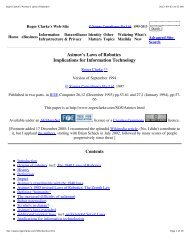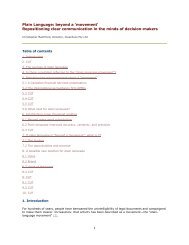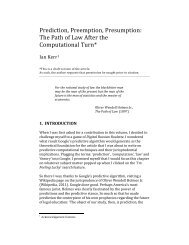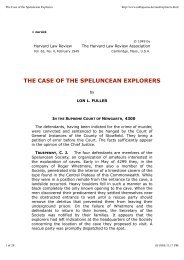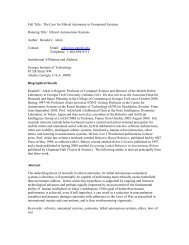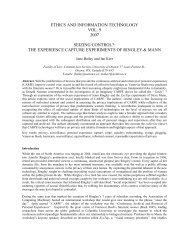Materializing Morality: Design Ethics and Technological Mediation.
Materializing Morality: Design Ethics and Technological Mediation.
Materializing Morality: Design Ethics and Technological Mediation.
Create successful ePaper yourself
Turn your PDF publications into a flip-book with our unique Google optimized e-Paper software.
Verbeek / <strong>Materializing</strong> <strong>Morality</strong> 375<br />
The activities of Eternally Yours can be seen as a form of anticipating<br />
mediation by imagination. Sigrid Smits’s couch <strong>and</strong> Sven Adolph’s heater<br />
were designed explicitly from the perspective of their possible mediating<br />
role in the interactions <strong>and</strong> affective relationships their owners will have<br />
with them. They mediate the behavior of their users in such a way that the<br />
users are likely to get attached more to these artifacts than to other couches<br />
or heaters. These products were designed not only as functional objects<br />
but also as artifacts that actively mediate the behavior of their users. The<br />
products of Eternally Yours embody an environmental ethics: they seduce<br />
their users to cherish them rather than throwing them away prematurely.<br />
Augmenting Constructive Technology Assessment<br />
A second way to make an informed prediction about the mediating role of<br />
a technology-in-design is a more systematic one. To establish a connection<br />
between the context of use <strong>and</strong> the context of design, designers could also<br />
employ a method that was developed precisely for making such a connection:<br />
the method of constructive technology assessment (CTA; cf. Schot 1992; Rip,<br />
Misa, <strong>and</strong> Schot 1995). CTA creates a link between the contexts of design<br />
<strong>and</strong> use in a practical way: it aims to involve all relevant stakeholders in the<br />
design of technologies. To make use of the CTA methodology within the context<br />
of technological mediation, it needs to be augmented, though.<br />
CTA is based on an evolutionary view of technology development. The<br />
process of technology development is seen as generating variations that are<br />
exposed to a selection environment, which is formed by entities such as<br />
the market <strong>and</strong> government regulations. In this selection environment, only the<br />
fittest variations will survive. There is an important difference between the<br />
generation of technologies <strong>and</strong> the generation of biological species, though.<br />
Contrary to biological evolution, in technology development, there is a connection<br />
or nexus between variation <strong>and</strong> selection. After all, designers can<br />
anticipate the selection environment when they are designing technologies,<br />
to prevent that much effort is put into developing technologies that will not<br />
be accepted by consumers or by government regulations.<br />
CTA is a method to employ this nexus in a systematic way, by feeding<br />
back assessments of the technology-in-design by all relevant actors, such as<br />
users, pressure groups, designers, companies, <strong>and</strong> so forth, into the design<br />
process. It does so by organizing meetings of all relevant actors in which<br />
the aim is to reach consensus about the design of the technology that is constructively<br />
assessed. This form of technology assessment is called “constructive”<br />
because it does not assess technologies after they have been<br />
Downloaded from sth.sagepub.com at QUEENS UNIV LIBRARIES on November 30, 2011



